![]()
![]()
|
|
|
| Home | Resources and Links | Aircraft Design Forum | Tutorials | FSC Downloads | Aircraft Downloads | Vintage Aircraft Photos | Email Me |
| Microsoft Flight Simulator 2000 - Original Downloadable Aircraft |
|
All aircraft are for Microsoft
Flight Simulator 2000 (and CFSII where noted) only and are free to download. All aircraft ©2000-2001 by David Eckert and others where noted. Questions and comments are welcome: webmaster@daviator.com No files here may be not used for any purpose
without the express written consent of the author(s). Use of these models for
commercial ventures require payment to the author(s). Enjoy these models but please don't steal them and sell them. |
| About
my P-61B Black Widow After I visited the Mid Atlantic Air Museum over the holidays and seeing their P-61 under restoration, I was inspired. Iíd already started to build a P-61B add-on for the flightsim community, but I thought there had to be a way that I could help the museumís restoration efforts too. That's when Abacus approached me with an offer to purchase the rights to my model. I agreed with condition that a portion of it's sales go to MAAM for their P-61B restoration project. Click here to read more about the real airplane and to see how you can with it's restoration. Click here to to read about the flightsim model and see more screenshots. |
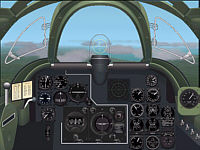 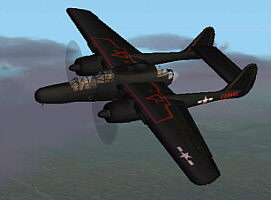 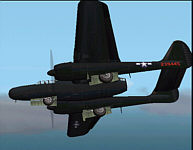
|
| Grumman TBM Avenger v1.a Prop texture and flap issue fix for v1 External
Stores Fix (201K) - Special thanks to Stuart Laycock for putting
this together. The first prototype flew in 1941 and after the Japanese attack on December 7, 1941, the Navy ordered it into production. The TBM first saw action during the battle of Midway. Unfortunately, of the six that took part, five were shot down. However, they had diverted the Japanese fighters and American Dauntless dive bombers successfully attacked Japanese carriers. After this major battle, the TBM was christened "Avenger". The Avenger had a large bomb bay capable of carrying a torpedo, a 1000 lb. bomb or twelve 100 lb. bombs. Other missions included laying down smoke screens and reconnaissance. To meet increasing orders, Eastern Aircraft, a division of General Motors, began building Avengers under license. Eastern was responsible for the majority of Avengers produced which were designated TBM's. Armament consisted of a single .50 caliber in the turret, another in a rear facing lower window and two forward firing .50's in the wings. |
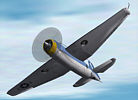   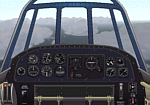
|
| Republic
P-43A Lancer This is an update featuring: much improved flight dynamics, Added missing supercharger, flaps are now correct split type, corrected non-operating fuel gauge. Also added sound by Bruce Thorson. Credits: Flight dynamics by Bob Boudoin and Bruce Thorson. WWII style gauges by R.L. Clark, borrowed from his B-26 Marauder. History: Built by Republic, the P-43 was a modification of the P-35. It had an early turbocharger and was quite fast for it's day. Roll was good but turn rate was poor. The turbocharger was not especially reliable and the fuel tanks were quite vulnerable, particularly in early models without self sealing tanks. The model was eventually dropped in favor of an all new model - the P-47B. 51 aircraft were eventually delivered to China under lend-lease and a few saw limited operation with the American Volunteer Group. |
  
|
| Amelia
Earharts Lockeed Electra 10E Panel by J.L. Stubbs is included www.flightsimmers.net/aeroswine Download updated flight dynamics by Bob
Boudoin. On July 2nd 1937, Earhart departed New Guinea bound for tiny Howland Island. 20 hours out of New Guinea, the Coast Guard cutter Itasca received this transmission from Earhart: "KHAQQ calling Itasca. We must be on you but cannot see you--gas is running low." Half an hour later the Coast Guard cutter received one last voice transmission from Earhart. She only gave her position. According to that transmission, Earhart was as much as 100 miles off course for making Howland Island. Nothing more was heard. |
 
|
| PT-13 Stearman Kaydet Panel Courtesy of J.L. Stubbs www.flightsimmers.net/aeroswine Download updated flight dynamics by Bruce Thorson. PT-13 Update Read the review on
flightsim.com |
 
|
| Kaman HH-43B Huskie The first helicopter purchased by the Air Force specifically for airborne fire-fighting and air base crash rescue. The twin intermeshing, counter-rotating rotors made the Huskie very stable in flight, and in fact, the downwash actually helped suppress fires. A number of Huskie crews set time-to-climb, altitude, and distance records. My father was the crew chief on the Huskie this one is modeled after. Maximum Speed 120 mph |
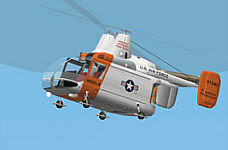 
|
| Sikorsky R-4B Hoverfly The R-4 was the world's first production helicopter. It was also the first to be used in saving a civilian life and to operate from ship's decks. 133 R-4s were procured between 1942 and 1945. The R-4 was first used in combat in May 1944. In a letter to a friend, Col. Philip G. Cochran, Commanding Officer (CO) of the 1st Air Commando Group, wrote "Today the 'egg-beater' went into action and the damn thing acted like it had good sense." |
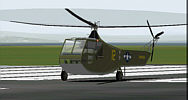 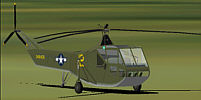
|
| Albatros D V D V flown by Hptm Richard Flashar, sporting the "mailed gauntlet" motif and the "lozenge" fabric wing covering. Armament consisted of the standard two synchronized 7.92 mm Spandau machine guns mounted over the engine. |
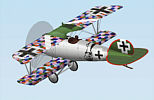 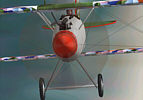
|